Looking to cut a perfect square hole in wood using a jigsaw? Wondering if it’s even possible? Read on to discover expert tips and tricks to achieve just that!
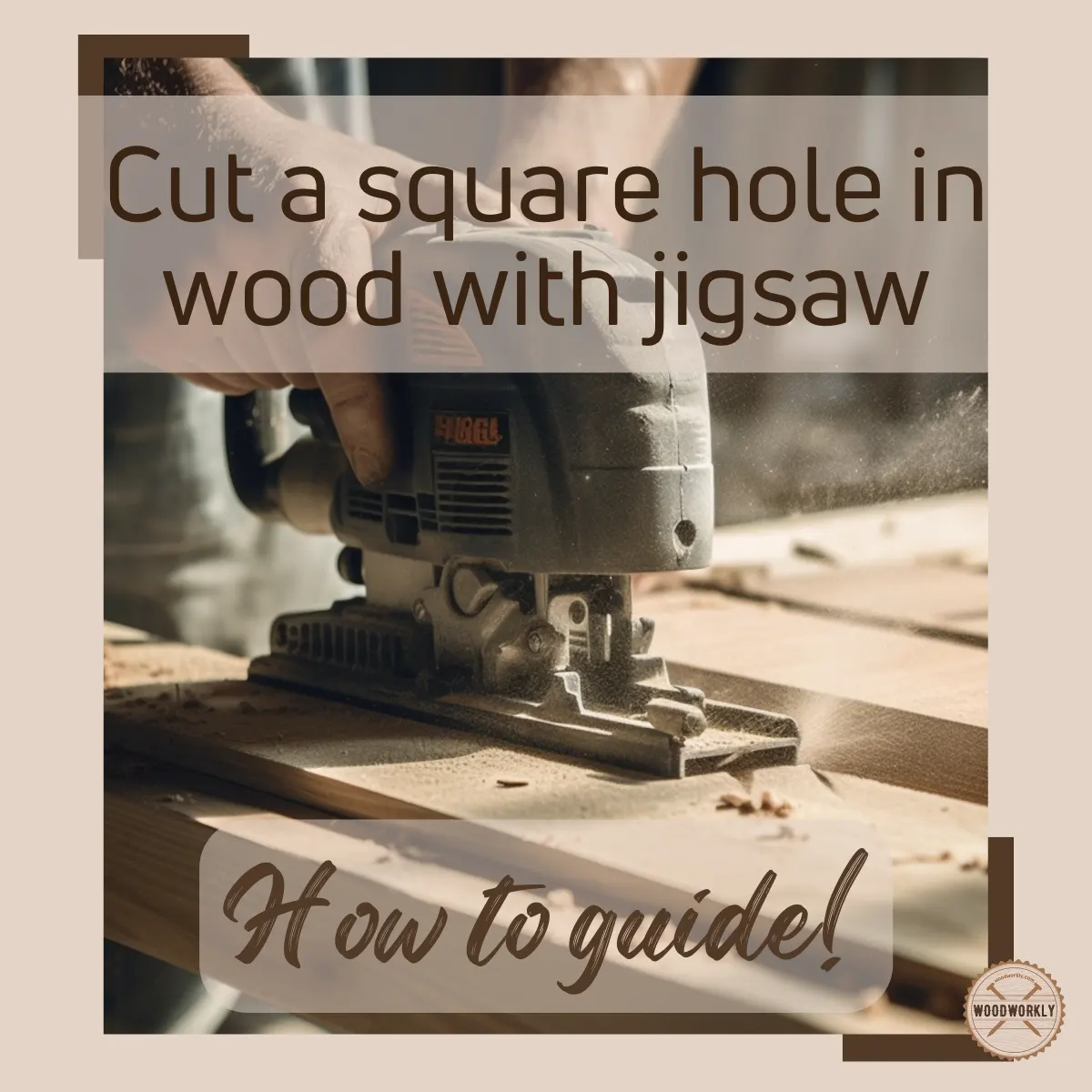
Are you struggling to cut a square hole in wood with a jigsaw? Don’t worry! this article is for you.
I have faced the same issue when I was a beginner in woodworking.
I went to many professional woodworkers in San Francisco asking solutions to my questions about cutting square holes in wood with a jigsaw since there was no internet in those days.
From the things that I have gathered from experts, I was able to make perfectly square cuts with jigsaws, but only after several practice projects.
Since the knowledge is meant to be shared, here I’m going to tell you all I know about, How to cut a square hole in wood with a jigsaw?
To cut a square hole in wood with a jigsaw, first, measure and mark the square hole area. Then, secure the wood using sawhorse or table edges. Next, create starter holes using a drill and start cutting following the marked area. Finally, smoothen the cut by sanding.
But that’s just the tip of the iceberg!

In this article, I’ll explore how to cut a square hole in wood with a jigsaw by describing each step in detail with many other tips, tricks, and techniques to make your project easier than it seems.
Stay with this comprehensive guide till the end to reveal the secret techniques that are useful when cutting perfectly square holes with a jigsaw.
Furthermore, I’ve answered some frequently asked questions as well.
Let’s jump in!
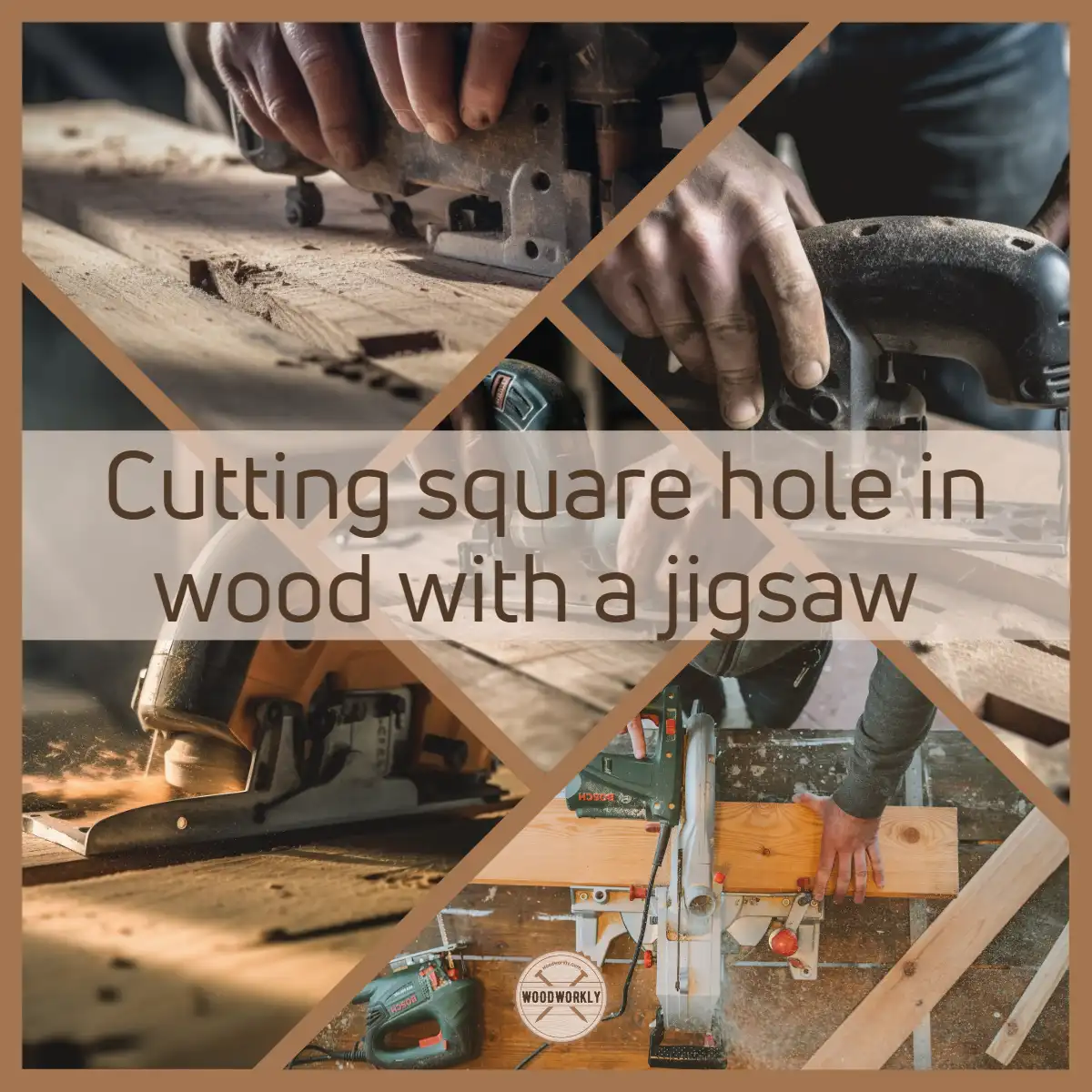
Can A Jigsaw Cut Square In Wood?
Yes, jigsaw can cut square in wood including square inlays and square holes. Yes, it’s challenging, but with enough practice, you can cut a square hole in wood with a jigsaw, like a piece of cake.
Jigsaw is the most popular woodworking tool for cutting square holes since it is not only efficient but also allows for a great amount of precision compared to other methods.
But first, you need to select the right blade type and technique you’re going to use for this entire process. Otherwise, there is a high possibility of making non-straight cuts.
With the right blade and technique, you can cut clean and sharp edges for your square hole making your woodworking project look professional and polished like a pro.
Jigsaw has a unique design compared to other power tools with a narrow, reciprocating blade, allowing it to make intricate cuts with ease.
Jigsaw can cut straight lines, curves, and even square holes, making it an invaluable tool in any woodworker’s arsenal.
I remember the first time I used to cut a square hole in wooden cabinet door after taking advice from professionals in my area, the result was near-perfect after a couple of practice sessions, and I genuinely felt proud.
Don’t worry! I’ll make you feel the same way. It is easy, especially with a tool like jigsaw.
When cutting a square hole with jigsaw make sure to pay close attention to the blade’s movement.
Generally, jigsaws have orbital settings that control the blade’s motion. Therefore, when cutting square holes, better to use a non-orbital or lo-orbital setting to gain a more precise cut.
Let’s have a look at the in-detail view about the type of blades suitable for cutting square holes.
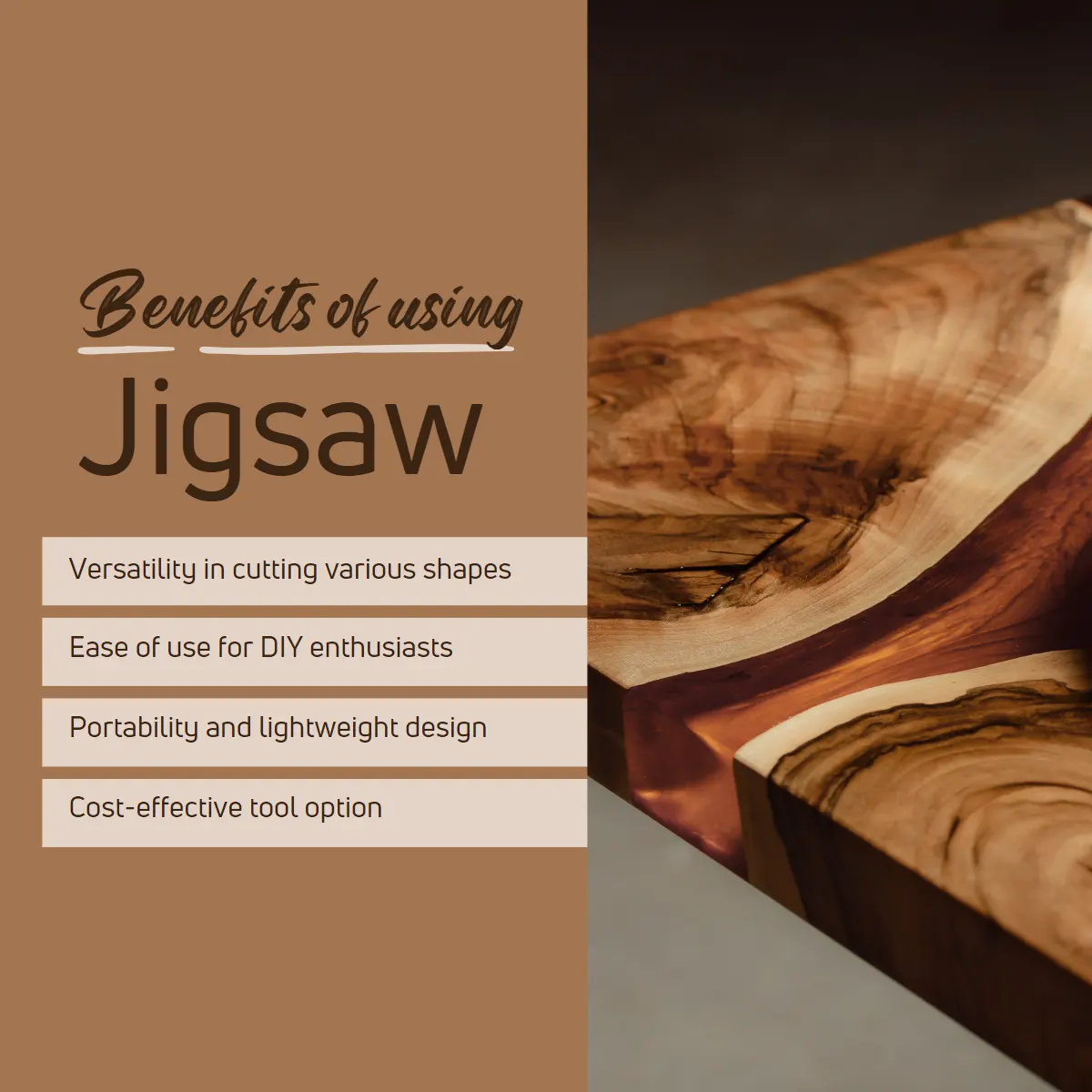
Suitable Jigsaw Blade Types For Cutting Square Holes
Selecting the right jigsaw blade type is crucial for achieving the desired results when cutting square holes in wood.
Jigsaw blades are available in many different types, sizes, and materials. Each one of them is specially designed for various cutting applications.
Here’re some useful things to consider when selecting a jigsaw blade for cutting square hole in wood,
- Tooth count
- Blade material
- Blade width
- T-shank vs U-shank blades
Let’s discuss each of them in detail.
Tool Count
There’s a term called TPI in jigsaw blades. TPI means Teeth Per Inch. So, a blade with a high tooth count (high TPI) usually makes a smoother cut.
But a blade with lower teeth count delivers a faster but rough cut.
When cutting square holes in wood, select a blade with a medium to high TPI to achieve clean cuts.
Blade Material
High carbon steel (HCS) blades are flexible and excellent for cutting softer wood. For harder woods, choose high-speed steel (HSS) blades or bi-steel blades, which can provide high durability and heat resistance.
Therefore, select the blade material by looking at the hardness of the wood you’ve selected to make the square hole.
Blade Width
A narrow jigsaw blade is great for more precise cuts, especially when making tight turns in the corners of the square hole.
Wider blades are more stable than narrow blades when making straight cuts, but they may struggle to control at tight corners.
In a square hole, you need to turn the jigsaw blade 4 times with exact 90-degree angles completing 360 degrees overall. Therefore, in my opinion, narrow jigsaw blades are good to make square hole in wood.
T-shank vs U-shank
T-shank blades are modern and more useful since the installation is easy with no tools needed for many modern jigsaws. U-shank blades need a special tool for installation and are less common.
But U-shank blades can still use if compatible with your jigsaw when cutting a square hole.
For example, when I cut square holes in a plywood bookshelf, I used a 12 TPI T-shank HCS blade, which provided the perfect balance of smoothness and cutting speed.
As you can see, jigsaw is more than capable of cutting square holes in wood, thanks to its unique design and versatility.
By selecting the appropriate blade type and employing the correct techniques, you can achieve clean, professional-looking square holes for your woodworking projects.
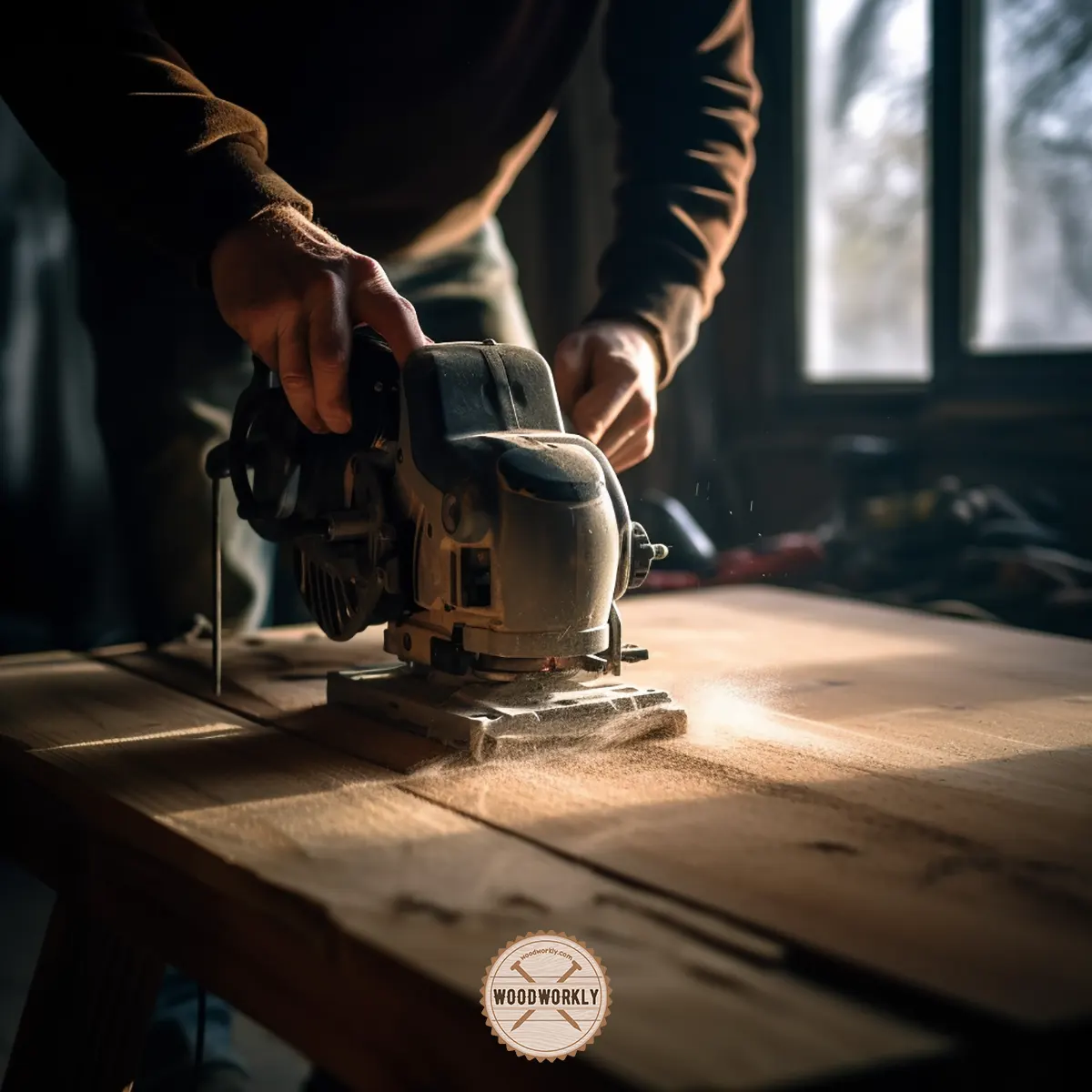
Let’s see what are the key factors that you should consider before making a square hole in wood with a jigsaw.
Factors To Consider When Cutting A Square Hole In Wood With A Jigsaw
When cutting a square hole in wood using a jigsaw, several factors affect the quality and the ease of your cuts.
As per my experience, these factors can make all the difference when cutting a square hole.
Here’re the factors to consider when cutting a square hole in wood with a jigsaw,
- Wood type
- Wood thickness
- Blade selection
- Jigsaw speed adjustment
- Orbital action settings
Let’s have a look at each of the above factors in detail to make your square cut on wood easily with a jigsaw.
1. Wood Type
The type of the wood you’re working on is a crucial factor when cutting a square hole since that determines the ease and precision of your cuts.
Softwoods like pine and cedar are easier to cut with a jigsaw while hardwoods like oak and maple are challenging due to their high density.
Make sure to select a suitable blade type when dealing with different wood types to make smooth cuts without damaging or chipping the material.
2. Wood Thickness
The thickness of the wood plank you’re going to cut is important to consider when selecting jigsaw blades.
You need to make sure that the jigsaw blade you selected is able to reach the material entirely.
Consider the cutting capacity of your jigsaw and select the blade that can accommodate the wood’s thickness.
For example, when cutting thicker wood, you need to have a jigsaw blade with a slower cutting speed and more powerful jigsaw models.
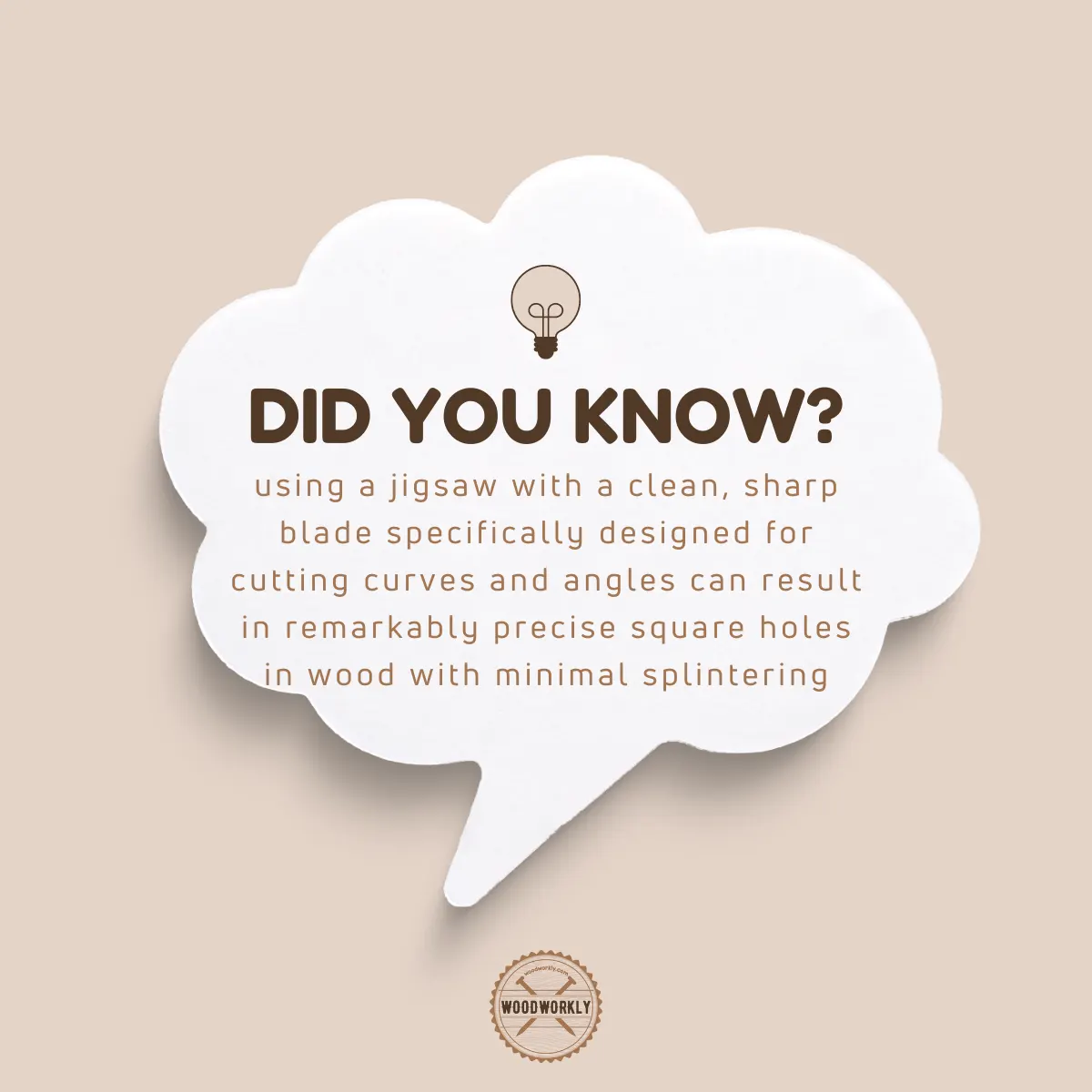
3. Blade Selection
As I already mentioned earlier, you need to have a good understanding about T-shank blades, U-shank blades, tooth count of the blade, and the material considerations before making the cut.
T-shank and U-shank have different installation methods. T-shank blades are popular, and modern need no tool for the installation process, and compatible with almost all modern jigsaws.
But U-shank blades need a special tool for the installation and may not be compatible with all the modern jigsaws.
Therefore, select the blade type based on your jigsaw model reading the manufacturer’s guide.
Selecting the right blade tooth count (TPI) is essential to make smoother and more precise cuts.
As a general rule, go for higher TPI blades for smoother cuts and lower TPI blades for faster and rougher cuts.
High-carbon steel (HCS) blades work well for cutting square holes in softwoods while high-speed steel or bi-metal blades are great for hardwoods due to their high durability and heat resistance.
4. Jigsaw Speed Adjustment
Adjusting the cutting speed of your jigsaw is important to optimize the cutting performance based on the material.
Mostly, slower speeds of jigsaw are great for hardwoods and thicker materials, while faster speeds are suitable for cutting softwoods and thinner materials.
Many of the jigsaws have the facility to control the speed setting. You can fine-tune the cutting speed of jigsaw based on the type of wood you got.
5. Orbital Action Settings
Orbital action settings control the blade’s movement during cutting, affecting the cut’s speed and smoothness.
For cutting square hole in wood, it’s best to use a non-orbital or low orbital setting to ensure more precise cuts.
Be sure to consult your jigsaw manual for specific guidance on adjusting the orbital action for your particular model.
Understanding and considering these factors when cutting a square hole in wood with a jigsaw can lead to better results and a more enjoyable woodworking experience.
By selecting the right blade, adjusting the jigsaw’s speed and control settings, and taking the wood type and thickness into account, you’ll be well on your way to cutting perfect square holes in any wood.
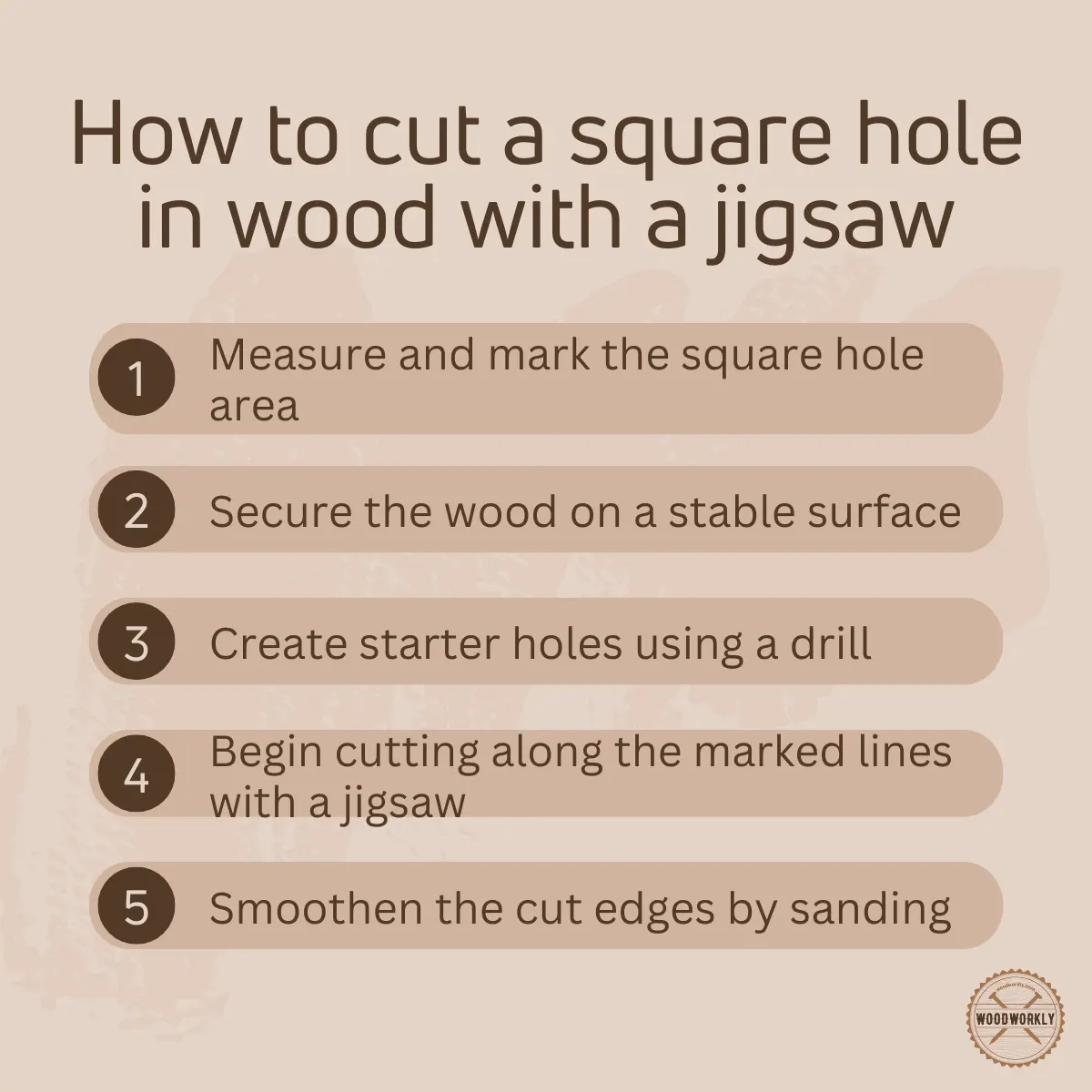
Let’s see what tools you should use with a jigsaw when cutting a square hole in wood.
Tools For Cutting Square Hole In Wood
- Pencil or marking tool
- Measuring tape
- Framing square or straightedge
- Fine grit sandpaper
- Sanding blocks or oscillating tool
- Power drill
- Appropriate drill bit size
Enough chit-chats! Let’s head into the hot topic of discussing the procedure of cutting a square hole with a jigsaw correctly without messing things up.
How To Cut A Square Hole In Wood With A Jigsaw?
Cutting a square hole in wood is a challenging task, but with the right technique and some practice, you can achieve excellent results.
Here’re the steps you need to follow when cutting a square hole in wood with a jigsaw,
- Measure and mark the square hole area.
- Secure the wood.
- Create starter holes using a drill.
- Start cutting the market area.
- Smoothen the square cut by sanding.
Let’s have a look at each of the above steps in detail to cut square holes in any wood without making any mistakes.
1. Measure And Mark The Square Hole Area
First, you need to mark the square hole area before starting to make the cuts.
Take the measuring tape and carpenter’s square to get accurate measurements of the square you’re going to gut and mark with the pencil or marking tool.
Double-check the measurements you’ve taken before moving on to the next step since errors at this stage might lead to uneven cuts.
After taking the measurements, take the straight edge or carpenter’s square to mark the 90-degree angle of the square hole.
Check whether the lines are parallel with opposite lines and have a 90-degree angle in the corners.
Lines you marked with the pencil should be visible since you’ll have to guide the jigsaw along those lines to make straight cuts.
2. Secure The Wood
Next, you need to secure the wood to keep it steady without letting it make any individual movements during the cutting process.
To do that, you can use a sawhorse, table edges, or a workbench with clamps to hold the wood firmly in place.
Make sure the wood is stable and won’t shift during the cutting process.
Plus, make sure the area you’ll be cutting the square hole has adequate support underneath.
Having good support underneath helps prevent the jigsaw blade from binding or causing the wood to splinter when you cut.
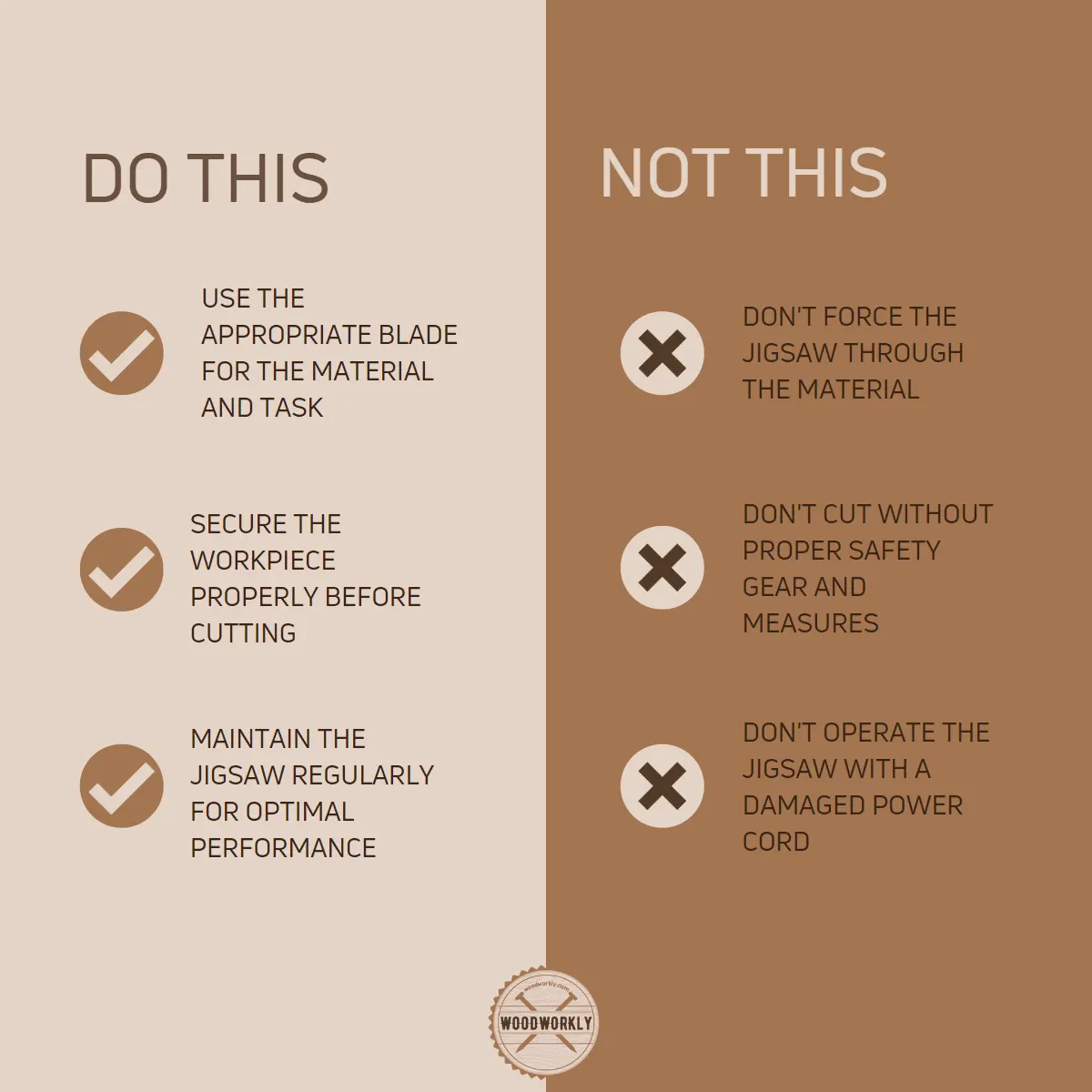
3. Create Starter Holes Using A Drill
Before you start cutting the square hole in the wood with your jigsaw, you’ll need to create starter holes using a drill.
The starter hole is also known as the pilot hole.
Choose a drill bit slightly larger than your jigsaw blade’s width and make sure to drill the holes in each corner of the marked square hole.
Making a pilot hole before starting to cut the square hole in the wood allows the jigsaw blade to fit comfortably and ensures a clean starting point for your cuts.
When drilling the pilot holes, make sure they’re located inside the marked square hole, close to the corners but not too close to the edge.
This will help prevent the wood from splintering or cracking during the cutting process.
4. Start Cutting the Marked Area
Insert the jigsaw blade into one of the starter holes and begin cutting along the marked lines by keeping your hands steady.
Take the control of jigsaw with your hands without letting the machine move freely to make smooth and straight cuts with ease.
Make sure to follow the markings closely and keep a steady hand to ensure accurate cuts.
Don’t rush the process; take your time to achieve clean, precise lines to get a square hole as you want.
As you cut, sawdust can build up and make it difficult to see your markings. Plus, sawdust can cause skin irritations.
In order to remove sawdust from the surface, clean the area with a clean rag or use a proper dust collection pipe system to collect sawdust.
The collected sawdust can use to make fertilizer upon drying with a dryer.
This will help maintain visibility and ensure you’re staying on track with your markings.
5. Smoothen the Square Cut by Sanding
Once you’ve completed making square hole in wood, use sandpaper or a power sander to smooth the edges of the square hole.
Start with a coarse grit sandpaper and work your way up to a finer grit for a smooth finish.
Make sure to apply even pressure when sanding to even out the surrounding wood color and to avoid surrounding are damaging due to rough sanding.
This step will help eliminate any burrs or rough edges left behind by the jigsaw.
Now, focus closely on square hole, as these areas may have some burrs or rough edges that need extra attention.
Use a small, flat file or sandpaper wrapped around a flat object to carefully remove any imperfections and achieve a smooth finish.
This attention to detail will ensure your square hole looks professional and polished and super smooth.
By following these steps and incorporating the tips provided, you can successfully cut a square hole in wood with a jigsaw.
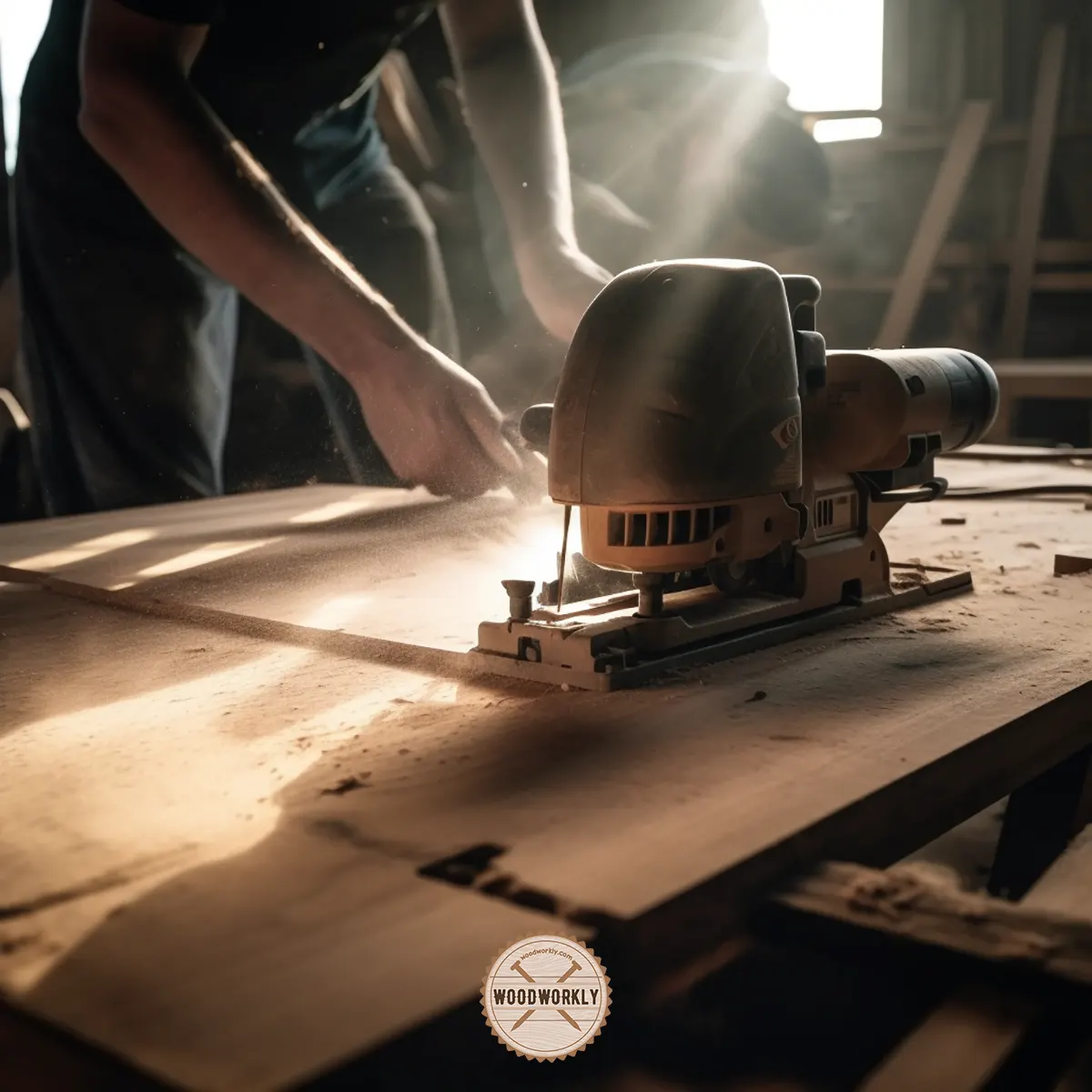
Congrats folks! Now you know how to cut a square hole in wood with a jigsaw perfectly following the correct procedure.
Practice makes perfect, so don’t be discouraged if your first attempt isn’t flawless. With time and experience, you’ll be able to create clean, accurate square holes in wood with ease.
Tips To Cut A Perfectly Square Hole In Wood With A Jigsaw
As we all know, cutting a square hole in wood can be challenging especially when if you’re a beginner.
That’s where tips and tricks come in. Most of the tips below I learned from experience after working with so many woods when cutting holes and stuff.
Here’re some useful tips that are important when cutting a square hole in wood with a jigsaw,
- Choose the right blade.
- Take your time, don’t rush the process.
- Use a straight edge or guide.
- Maintain control and stability.
- Make relief cuts.
- Practice on scrap wood first.
Let’s have a look at each of the above useful tips to make your project succeed and to cut square hole in wood easily without making any mistakes.
Choose The Right Blade
Selecting the right jigsaw blade is super important to make precise and smooth cuts when making square holes.
Use blades with higher tooth count for smoother cuts and try to use blades that are specially designed for cutting clean edges in wood.
Ask help from your local store professionals to find the blade type that suits you the most.
T-shank blades provide better stability and control during the cutting process. They can improve the quality of your cuts when making a square hole in wood.
Take Your Time, Don’t Rush The Process
Rushing a project like cutting a square hole can lead to making uneven and non-straight cuts.
Even if you’re a beginner or a pro, I advise you not to rush the process. Just take your time and try to do a better job on the first few occasions.
Slow down and focus closely on marked lines and align your jigsaw along those lines all the time.
Allow the jigsaw to do the job and apply gentle pressure to guide it along the cutting direction.
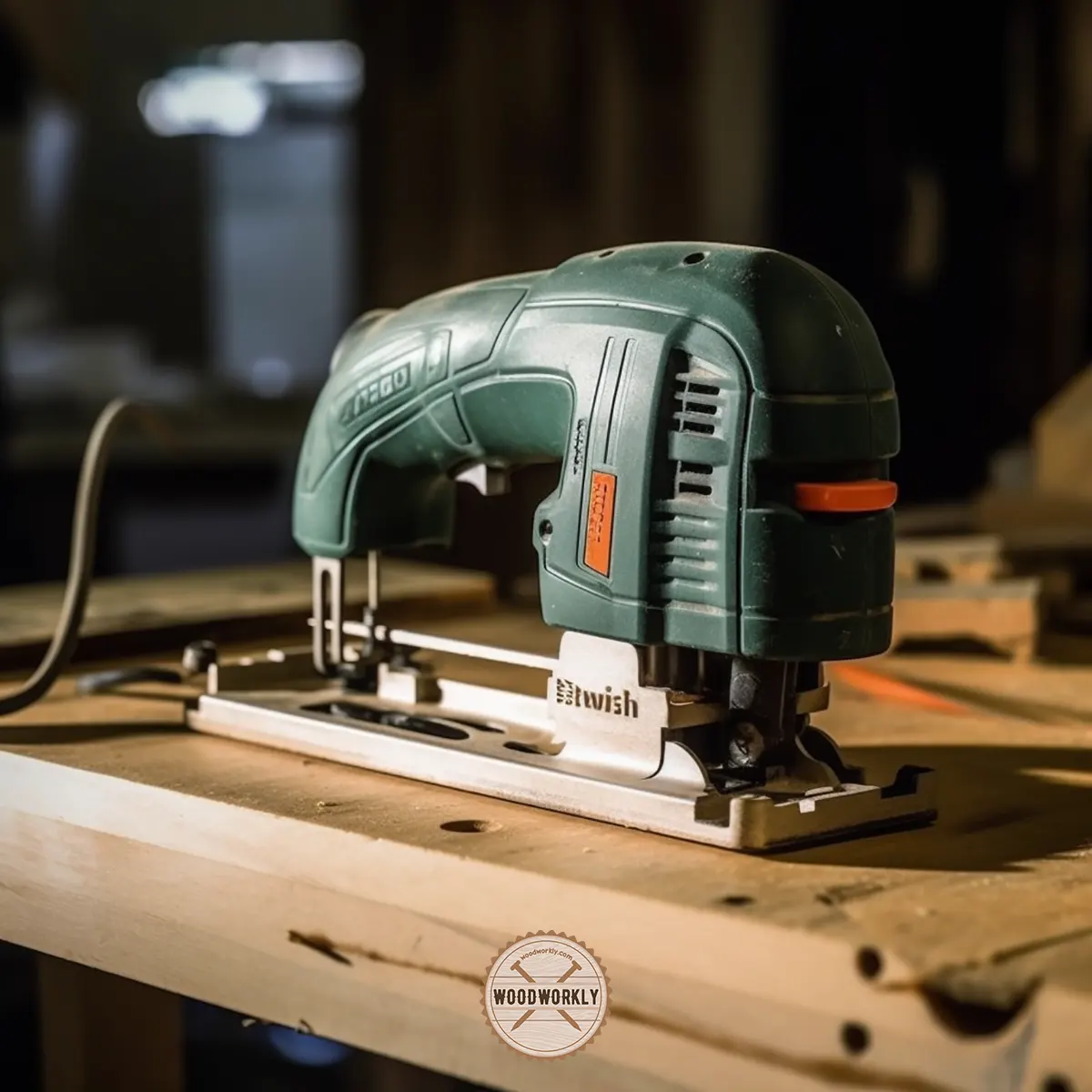
Use Straight Edge Or Guide
Straight edges or guides help you to maintain a straight line when cutting a square hole with s jigsaw.
First clamp a straight edge such as a metal ruler or a piece of scrap wood, parallel to the marked line.
This will help you to cut a square hole by providing a physical guide for the jigsaw to follow ensuing a straighter cut.
Maintain Control And Stability
Make sure to keep the jigsaw stable and steady while you’re cutting square hole to make straight and even cuts.
This helps you to make a perfectly square hole in wood. in order to do that, secure your workpiece by clamping and supporting it to avoid individual movements during the cutting process.
Plus, hold the jigsaw with both hands and apply downward pressure to keep the base plate flat against the wood you cut.
Make Relief Cuts
Make relief cuts for tight corners. There’re 4 90-degree angle corners you have to take during cutting a square hole in wood.
So, making small relief cuts that extend from the corner of the square hole to the edge of the wood, allows jigsaw blade to move more freely and prevent building.
This technique helps you to make sharp and smooth cuts in the corners of your square hole.
Practice On Scrap Wood
Before heading into the main project, take scrap wood from the same wood material and practice with it using the same procedure to make straight and even cuts a couple of times.
This will help you to become familiar with the handling techniques of the jigsaw and cutting process.
Practice makes you a pro at this game. The more you practice, the more you succeed.
By following the tips and techniques above you’ll be able to make a super smooth cut when making a square hole in wood with no issues at all.

Safety Precautions To Follow When Cutting A Square Hole In Wood
Working with power tools like jigsaw can be dangerous especially when you don’t follow the safety guidelines.
Your safety is the top priority when cutting a square hole in the wood with a jigsaw.
Here’re some essential tips to follow during the process,
- Wear appropriate safety gear when cutting such as goggles, ear protection, dust mask, gloves, sturdy closed-toe shoes
- Keep your work area clean and organized.
- Inspect your tools before use.
- Secure your workpiece properly.
- Use the right blade for the cutting task.
- Follow the manufacturer’s safety instructions.
Alternative Methods To Cut Square Holes In Wood
As we already know jigsaw does such a wonderful job when cutting a square hole in wood, there’re some alternative methods as well which you can follow.
These methods are useful when you don’t have a jigsaw with you or when your jigsaw is broken.
Here’re some alternative methods to cut square holes in wood,
- Using a router and a straight-edge guide.
- Using a hand saw and chisel.
- Oscillating multi-tools.
- Using hole saws and Forstner bits.
Let’s have a look at how to cut a square hole in wood using those alternative methods as well as the pros and cons of each.
Using a Router and a Straight-Edge Guide
A router is a powerful woodworking tool that can create clean, precise cuts in wood.
Here’re the steps you need to follow when cutting a square hole in the wood with a router,
- Secure your workpiece to a stable surface.
- Install an appropriate straight bit in the router.
- Adjust the router’s depth to match the thickness of the wood.
- Clamp a straight-edge guide to the workpiece, aligning it with your markings.
- Run the router along the guide, making multiple passes to remove the material within the square hole.
In order to know more details, read my latest post about, How to cut a square hole in the wood with a router like a pro!
Let’s see some pros and cons you might face when working with a router,
| Pros | Cons |
| Precise and clean cuts | Can be challenging for beginners to use |
| Smooth, professional-looking finish | Requires additional accessories |
| Adjustable depth for various wood thicknesses | May not be suitable for tight spaces |
| Suitable for both straight and curved cuts | Can be more expensive than other tools |
| Can create intricate designs and shapes | Requires a steady hand for best results |
Using a Hand Saw and Chisel
For those who prefer traditional woodworking techniques, a hand saw and chisel can be used to cut a square hole in wood.
Here’re the steps you need to follow when cutting a square hole in the wood with a hand saw and chisel,
- Secure the workpiece to a stable surface.
- Cut along the marked lines using a hand saw, stopping just before the corners.
- Use a chisel to remove the remaining material in the corners, ensuring a square shape.
Let’s see some pros and cons you might face when working with a hand saw and chisel,
| Pros | Cons |
| Low cost, no need for power tools | Requires more physical effort |
| Simple and easy to use | Less precision compared to powered tools |
| Suitable for small projects and tight spaces | Slower process |
| No electricity is needed, great for remote areas | Can be difficult to achieve a clean finish |
| Allows for greater control in tight corners | May require additional cleanup, such as sanding |
Oscillating Multi-Tools
Oscillating multi-tools are versatile handheld power tools that can be used for various cutting tasks, including cutting square holes in wood.
With the appropriate blade attachment, you can quickly and easily cut square holes with an oscillating multi-tool.
This method is ideal for tight spaces or situations where other tools may be challenging to use.
Hole Saws and Forstner Bits
For smaller square holes, a combination of hole saws and Forstner bits can be used.
Begin by drilling a round hole with a hole saw or Forstner bit, then use a chisel or a small hand saw to square the corners.
This method works well for tasks like installing electrical outlets in wooden panels or creating small openings for hardware.
Compare the differences, pros, and cons of each method and select the one that suits you the most and practices with several times to be a pro at cutting square holes in wood.
That’s it, folks! Hope you were able to know everything you wanted to know about, how to cut a square hole in wood with a jigsaw in detail.
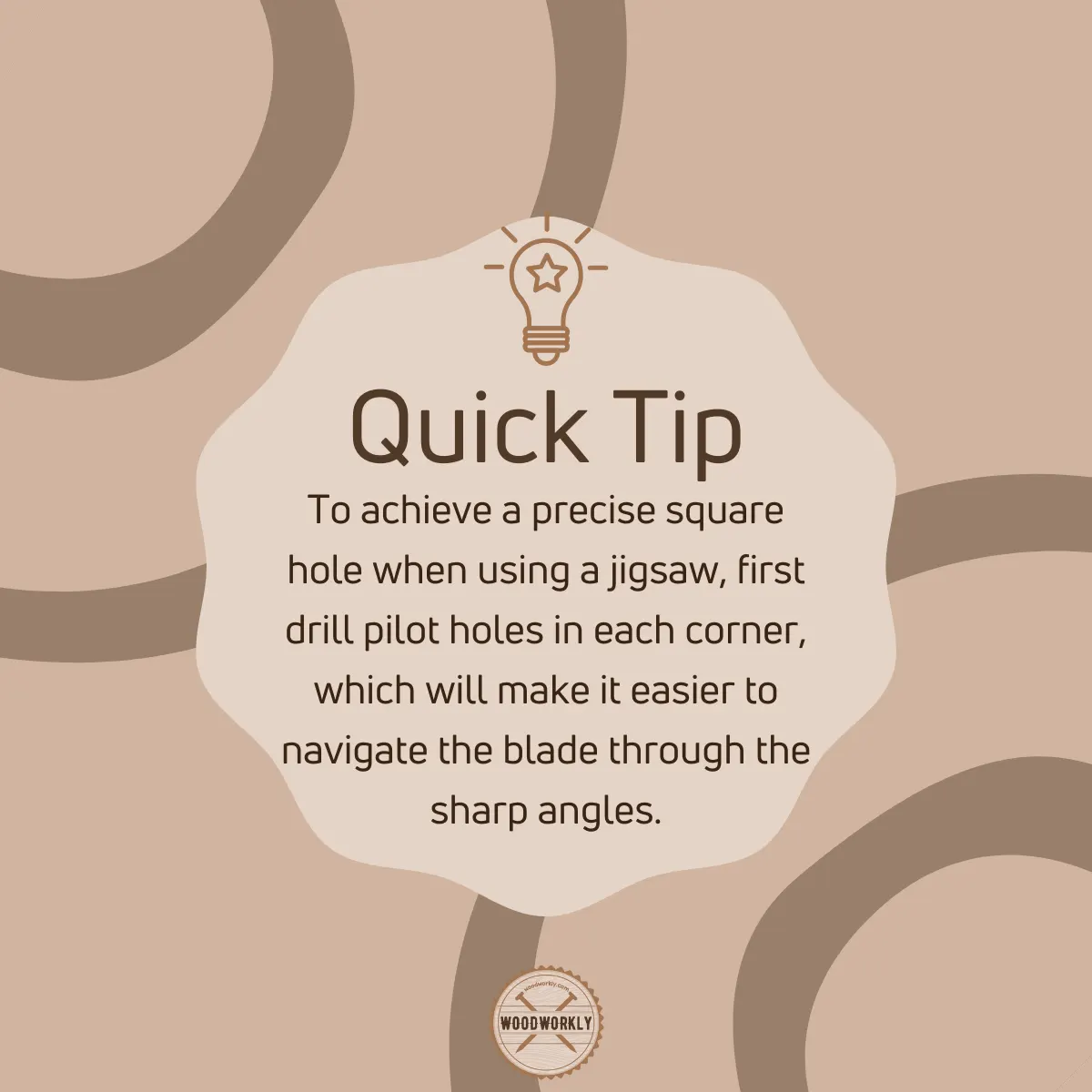
Let’s answer some frequently asked questions as well.
Can I Use Any Type Of Jigsaw Blade To Cut A Square Hole In Wood?
No, not all jigsaw blades are suitable for cutting square holes in wood.
Look for blades with a higher tooth count, which provides smoother cuts, and opt for T-shank blades as they offer better stability and compatibility with most modern jigsaws.
Plus, select blades specifically designed for cutting wood, as they have teeth designed for efficient and clean cuts.
How Can I Ensure That My Square Hole Has Straight And Even Edges?
Follow the below steps to achieve straight and even edges,
- Use a carpenter’s square or a combination square to mark accurate 90-degree angles.
- Secure the workpiece properly to prevent movement during cutting.
- Use a sharp, high-quality blade suitable for cutting wood.
- Take your time and let the jigsaw do the work, applying gentle pressure while maintaining control.
Is There A Trick To Cutting Sharp Corners With A Jigsaw?
Cutting sharp corners with a jigsaw can be challenging due to the blade’s curved cutting action.
Follow the below steps to make sharp corners with a jigsaw,
- Make starter holes at each corner using a drill, allowing the jigsaw blade to start and finish each cut cleanly.
- Use a coping or scroll saw to make precise corner cuts.
- After cutting with the jigsaw, use a chisel or a fine-toothed hand saw to clean up and square off the corners.
How Do I Prevent Tear-Out When Cutting A Square Hole With A Jigsaw?
Tear-out can be a common issue when cutting with a jigsaw.
Follow the below steps to minimize tear-outs when cutting a square hole with a jigsaw,
- Use a high-tooth-count blade designed for cutting wood.
- Apply masking tape or painter’s tape along the cut line to help reduce splintering.
- Cut at a slower speed, allowing the blade to make a cleaner cut.
- Support the workpiece from underneath to prevent vibration and movement.
Did I cover all you wanted to know about How To Cut A Square Hole In Wood With A Jigsaw?
In this article, I’ve deeply talked about how to cut a square hole in wood with a jigsaw without messing things up. I’ve described each step separately and added some tips and techniques to make your cutting process a lot easier.
To cut a square hole in wood with a jigsaw, measure and mark the square area, secure the wood, create starter holes using a drill, cut along the marked lines with a jigsaw, and finish by sanding the edges for smoothness. Use a suitable blade and follow safety precautions for best results.
Furthermore, I’ve answered some frequently asked questions as well
Hope you knew everything about how to cut a square hole in wood with a jigsaw with this comprehensive guide.
Ultimately practice is what makes you perfect. Therefore, practice with your jigsaw using scarp woods several times before heading into the main project. Happy woodworking!